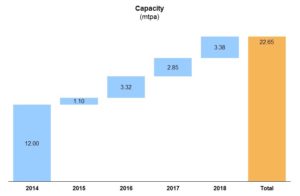
The production of ammonia from natural gas is another option to monetize natural gas. Ammonia has been produced from natural gas since the early 20th century by way of the Haber-Bosch process. This is a proven and mature process that is widely practiced by many companies.
Although natural gas is the most common feedstock, ammonia can also be derived from coal as commonly practiced in China, which produces ~30% of the world’s ammonia. India produces ~10% of ammonia each year and the United States and Russia produce 7% a piece. Global supply by region is shown in exhibit 1.
Ammonia’s chief use is as a fertilizer, often in the form of urea, accounting for 80% of demand each year. The other 20% is used in chemicals, explosives, and numerous other small uses. Demand for ammonia is driven mainly for its use as a fertilizer. As developing and emerging countries increase adoption of a more western-style diet made up of more grain-fed animal proteins, the demand for grain, and subsequently ammonia, will increase. Growth rates are projected at 2.7% annually through 2018.
There are ~60 ammonia plants in North America with another 35 to be built or expanded. Almost 75% of all ammonia produced in North America comes from three players: CF Industries (~40%), Agrium (~18%), and Koch Industries (~13%). Today, the U.S. produces ~12 mtpa of ammonia with another 10 mtpa through 35 planned projects including expansions. Assuming all of the planned capacity is built use about 0.9 Bcf/d of natural gas will be required to satisfy feedstock needs. Exhibit 2 shows planned ammonia capacity increased by year through 2018.
Unlike methanol or LNG, these ammonia projects are geared for domestic use, rather than exportation. The United States currently imports ~17 mtpa of ammonia and ammonia-based products (urea and other fertilizer) each year. About two-thirds of U.S. ammonia imports come from Trinidad and Tobago. It is likely that the added ammonia capacity will not turn the United States into an exporter of ammonia, but will serve to displace some of the ammonia imports. Natural gas monetization through ammonia offers a market with a domestic need, driven by agriculture, through a proven chemical process.
-Tyler Wilson and Uday Turaga





















